Matador Network's Blog, page 773
October 1, 2020
Japan is reopening its borders
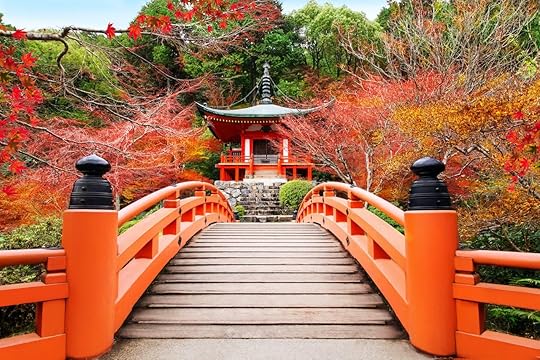
Japan is starting to lift its travel restrictions and open its borders to international travel — but that doesn’t include everyone. Starting October 1, Japan will welcome foreigners from all countries with approved new long-stay visas (over three months) — but not to tourists.
Everyone entering the country will be required to test negative for COVID-19 at least 72 hours before entering the country and self-isolate for 14 days upon arrival.
Only 1,000 foreigners will be allowed in per day, not including Japanese nationals, partially not to overwhelm testing capabilities.
Accepting tourists within its border again is a later phase of Japan’s reopening plan. The progression of the reopening process likely depends on the evolution of the pandemic and how Japan’s COVID-19 case numbers change as restrictions are lifted. 
More like thisTravelLesser-known Tohoku is the perfect place to experience Japan’s tranquil side
The post Japan is starting to reopen its borders to international travel appeared first on Matador Network.

Joshua trees get endangered status
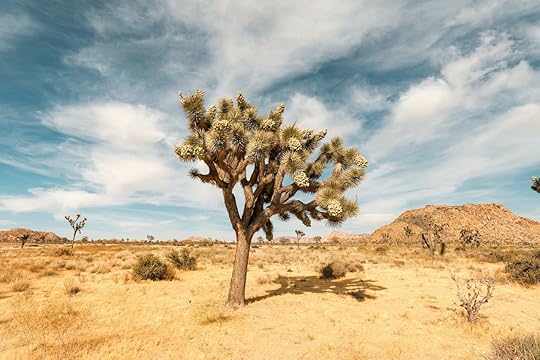
Thanks to climate change, the famous Joshua trees found in California’s Mojave Desert are in danger. To protect these trees from dying out by the end of the century, the Center for Biological Diversity filed a petition to protect Joshua trees under California’s Endangered Species Act. After California’s Fish and Game Commission accepted the petition, Joshua trees became the first plant species to be protected due to climate change threats. While the protection is due to last one year for now, another vote in 12 months’ time could make it permanent.
A study shows that by the end of this century, only 0.2 percent of the Joshua tree habitat will remain intact unless drastic action is taken.
The droughts that have plagued California make the soil too dry for young Joshua trees to grow healthy. The wildfires that the state is experiencing are also damaging the environment of the plant, and with temperatures rising, there’s very little hope in sight for the iconic Joshua trees.
During the year of protection, it will be illegal to damage, cut down, or remove a Joshua tree without special permits. If the protection remains in place, state and local agencies will develop a species recovery plan and strategy to protect the plant from the effects of climate change.
Brendan Cummings, the conservation director for the Center for Biological Diversity and author of the petition, said in a statement, “This is a huge victory for these beautiful trees and their fragile desert ecosystem. If Joshua trees are to survive the inhospitable climate we’re giving them, the first and most important thing we can do is protect their habitat. This decision will do that across most of their range.” 
More like thisParks + WildernessThe 7 coolest tree tunnels around the world
The post Joshua trees are the first plant to be granted protection because of climate change appeared first on Matador Network.

Indigenous culture in Tofino, Canada
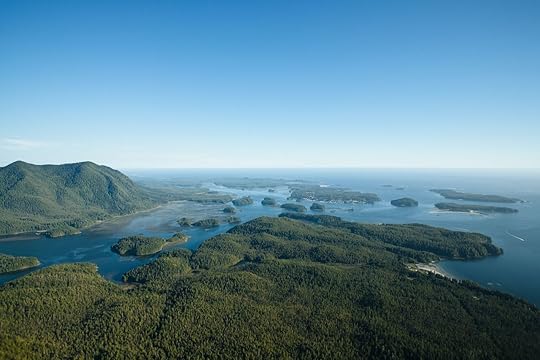
Many visitors to Tofino, British Columbia, have fallen under the spell of the Big Tree Trail on Wanachis-Hilth-huu-is, as Meares Island is known in the Tla-o-qui-aht language. Giant cedars draped in moss create a lush canopy over a narrow, warped boardwalk crowded by emerald ferns, and mushrooms the size of dinner plates blossom on tree trunks. But fewer might know that this enchanting forest was once in danger of disappearing entirely.
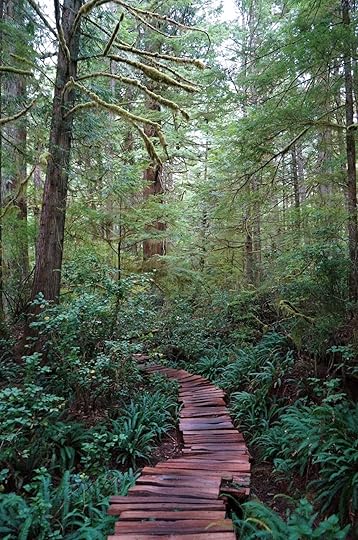
Photo: Chloe Berge
The island — a 32.7-square-mile expanse of temperate rainforest in the tidal waters of Clayoquot Sound — was declared a Tribal Park in 1984 by the Tla-o-qui-aht First Nation (one of 14 Nuu-chah-nulth First Nations on Western Vancouver Island), part of a growing movement to protect Indigenous land in the area from catastrophic logging. This environmental activism culminated in the Clayoquot protests of the early ‘90s — also known as the War in the Woods — where the Tla-o-qui-aht were joined by non-Indigenous allies in the fight. Nine hundred people were arrested, considered the largest act of civil disobedience in Canadian history at the time.
Moses Martin, a Tla-o-qui-aht elder who played a pivotal role in the protests and now leads natural history tours with the Indigenous-owned Clayoquot Wild, brings visitors from Tofino to the island. As the boat’s hull slices through the ocean, sending a salty spray up over its sides, Martin points out Stubbs Island. “The whole island was traded for two blankets and a barrel of molasses,” says Martin. This type of trade was not unusual when British Columbia was founded in 1871. Nuu-chah-nulth territories were illegally designated by Canada as Crown land and were deeded or sold off to settlers for next to nothing.
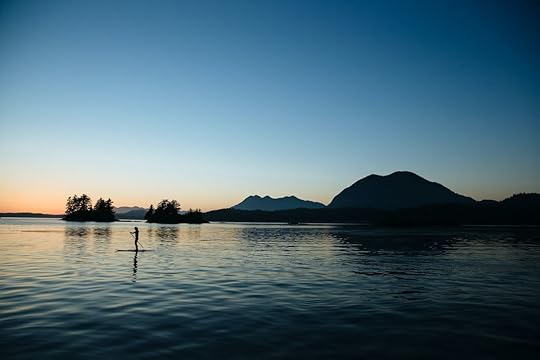
Photo: Jeremy Koreski
Not only is Meares Island part of the Tla-o-qui-aht’s sacred ancestral gardens that make up Clayoquot Sound, but it’s also a fragile ecosystem surrounded by estuaries, mudflats that are habitats for migratory birds, and the source of Tofino’s clean drinking water. And the only reason it’s still here is because of Indigenous stewards of the land, like Martin, who fought tirelessly to protect it.
“There are two main principles that apply to us as First Nations people, one being Iisaak,” says Martin. The word translates to “respect” or “to observe, appreciate, and act accordingly,” an ethos that at its core was in conflict with unsustainable logging. “We’re part of this circle of life, and if you impact anything within that circle you have to do it with respect,” explains Martin.
Even though the protests were successful in achieving a court injunction and warding off total destruction of the ecosystem, to this day no treaty has been signed with the Tla-o-qui-aht. British Columbia only recently made a commitment to change by signing a bill that enacts the United Nations Declaration on the Rights of Indigenous Peoples into law. But the community of Tofino is taking a more active role in championing First Nations’ right to self-government and long-term protection of the town’s Tribal Parks through Tribal Park Allies.
The organization was founded in 2018 by the Tla-o-qui-aht First Nation and includes a network of Indigenous and non-Indigenous businesses that publicize Tla-o-qui-aht rights and titles to the territory, educate employees on the town’s Indigenous history, and participate in community-building events. A one-percent ecosystem service fee is also collected, which enables Indigenous Tribal Park guardians to continue their land conservation work. This includes maintaining places like Meares Island and other parts of Clayoquot Sound, which are often environmentally degraded by squatters and illegal campers.
“It’s creating sustainable livelihoods and reconnecting people with their culture and history, while also enabling the Clayoquot [First Nation] communities to participate in the tourism economy,” says Julian Hockin-Grant, coordinator at Tribal Park Allies.

Photo: Mark Hobson
The new Hotel Zed was the Tribal Park Allies first accommodation partner. Stepping into the technicolor ‘70s-inspired lobby, guests are immediately greeted by three large-scale historical photos of Clayoquot protesters. The hotel also worked with three local writers — one of them Gisele Martin of the Tla-o-qui-aht First Nation — to create a book, Iisaak in the Garden, which (post-COVID-19) will be in every guestroom and tells the story of the protests. “When people come here, they have this amazing experience because the land is so unreal, and this education just makes that connection a lot stronger,” says Trina Notman, vice president of communications for Hotel Zed, who spearheaded the book’s creation.
Arriving at other Tribal Park Ally businesses like land-to-table 1909 Kitchen, or Common Loaf Bake Shop, travelers are greeted by the heady aroma of fresh bread and coffee instead of photos, but these places are no less devoted to the cause. Maureen Fraser, the owner of Common Loaf, was one of the Tla-o-qui-aht’s original allies, a key figure in the decades-long Clayoquot protests and an original member of Friends of Clayoquot Sound.
“Moses Martin gave me an honorary Tribal Parks Allies designation,” says Fraser. Throughout the uprising, the bakery supplied food to protest camps and acted as a place of refuge. “Everyone that lives and visits this area is benefiting from the fact that First Nations have been guardians of this landscape for thousands of years,” says Fraser. “I regard the Tribal Park Allies program as an acknowledgment of that.”
A core tenet of Tribal Parks Allies is the notion that reconciliation begins at a community level. “Reconciliation starts with each individual learning and trying to comprehend what has happened up until now in Canada, and then doing what they can to rectify the injustices,” says Fraser. “I hope travelers will start to pay attention to businesses that are supporting First Nation aspirations in the same way that they’re paying attention to the places that are serving wild seafood,” explains Fraser.
As a visitor or local, the close connection to the land in Tofino is undeniable. A sense of reverence before nature is easily felt in the morning veil of coastal fog and in the cold, choppy ocean surf. In the briny flavor of fresh oysters, and in the towering old-growth trees that reach for a grey, coastal sky. The mistake is to see ourselves as separate from this wild landscape.

Photo: Jeremy Koreski
“We’re trying to reconceptualize conservation in that way,” says Hockin-Grant. “The difference between a national park like Pacific Rim National Park and a Tribal Park is that for Tribal Park communities, people have to be recognized and accounted for as a keystone species in the ecosystem,” explains Hockin-Grant. “Beyond any natural processes, it’s political decisions and community decisions that lead to the enrichment or degradation of an ecological system.”
Even living through a violent cultural genocide and systemic racism that persists to this day, Martin is hopeful about rebuilding First Nations’ relationship with Canada’s non-Indigenous people. A courageous, compassionate choice that should inspire a desire for meaningful reconciliation within us all. “The other main principle we live by as First Nations is ‘heshook-ish-tsawalk’,” says Martin, gesturing across Clayoquot Sound from behind the wheel of his motorboat. “It means everything is one, we are all connected.” 
More like thisOutdoorHow to have the perfect winter trip in Tofino, Canada
The post There’s more to Tofino than surfing: diving into the town’s Indigenous heart appeared first on Matador Network.

Thailand gives back to heroes
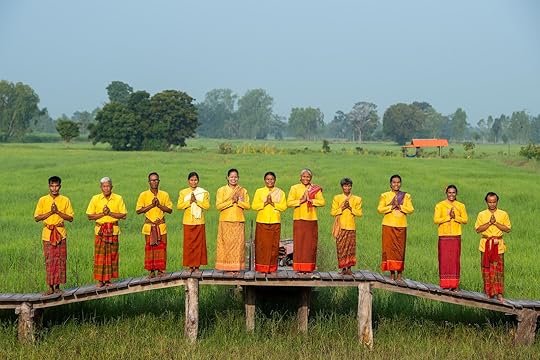
Thailand Gives Back to Heroes
Nominate your hero!
a collaboration between


The challenges of 2020 have shone a light on the heroes hiding in plain sight all around us. Essential workers — teachers, healthcare workers, grocery store clerks, firefighters, mail carriers — have risked their well-being to keep our worlds turning. And for that, they deserve something incredible.
That’s why the Tourism Authority of Thailand has partnered with Matador to award 5 essential workers the trip of a lifetime. Winners will receive round-trip premium economy air transportation to Thailand for themselves and a guest, along with boutique hotel accommodation. Who do you know that deserves some relaxation and rejuvenation in the world’s premier wellness destination?
To say THANK YOU to your favorite hero, fill out the form below and let us know why your nominee deserves to win a trip to Thailand. The more info you provide, the better your chances of winning. And yes, essential workers, you can nominate yourself!
We are accepting nominations for the Thailand Gives Back to Heroes Contest from October 1 – November 8, 2020. Winning entrants will be contacted via email. Terms and conditions apply. See the Official Rules for full details.
Nomination Form
Your name*
First
Last
Your email address*
Nominee's name*
First
Last
Nominee's occupation*Why does your nominee deserve to win a free trip to Thailand? Convince us!*OPTIONAL - Upload a photo, audio, or video clip to support your nomination (max 10mb).
Drop files here or

This contest is proudly presented in partnership with Tourism Authority of Thailand.
About Tourism Authority of Thailand
Located just 15 degrees north of the equator, “Amazing Thailand” is one of the Southeast Asia’s premier travel destinations and home to well-known tourist locations including the capital city of Bangkok, Chiang Mai, Phuket, Ko Samui, and Krabi. Known as the “land of smiles,” Thailand features some of the world’s finest luxury hotels and resorts, and offers visitors a rich tapestry of exotic architecture, culture, cuisines, traditions, and adventures. To learn more about the Tourism Authority of Thailand, visit www.ThailandInsider.com.
The post Thailand gives back to heroes appeared first on Matador Network.

Parrots swearing at visitors
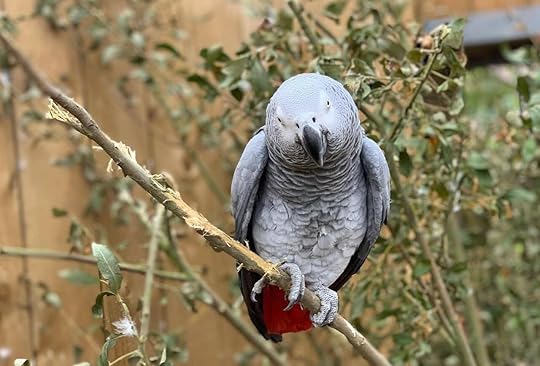
When children curse, they get put in time out. Apparently, that punishment is relatively similar at Lincolnshire Wildlife Park in England. When a group of African gray parrots at the park started swearing at visitors, the five birds were put in time out.
The birds, named Eric, Jade, Elsie, Tyson and Billy, were all donated to the park the same week in August from five different people and were put in quarantine together before being on display. Somehow, during that time period, they all started to swear at each other. “‘F**k off’ is the most common one,” Steve Nichols, the park’s CEO, said to CNN during an interview, but apparently, they know many profanities. “Anything you can think of,” he said.

Photo: Lincolnshire Wildlife Park/Facebook
The problem is that once around visitors, the animals were far from shy about showing off their vocabulary and the park was concerned about children being sworn at and learning some bad words from potty-mouthed parrots.
The birds may have been encouraged by park staff who laughed at their obscenities, as Nichols told Lincolnshire Live, “The more they swear the more you usually laugh which then triggers them to swear again.”
The birds also learned how to laugh at bad words, which created a vicious circle of profanities and laughter. “When you get four or five together that have learnt the swearing and naturally learnt the laughing so when one swears, one laughs and before you know it just got to be like an old working men’s club scenario where they are all just swearing and laughing,” he said.
To prevent the birds from insulting everyone who comes by their enclosure, the birds have been separated.
“What we will do now,” said Nichols, “is release them out but in separate areas so at least if they do swear it is not as bad as three or four of them all blasting it out at once.” 
More like thisWildlifeHow to make sure your animal encounter is ethical
The post Parrots in British wildlife park put in quarantine for swearing at visitors appeared first on Matador Network.

Movie bars that you can visit
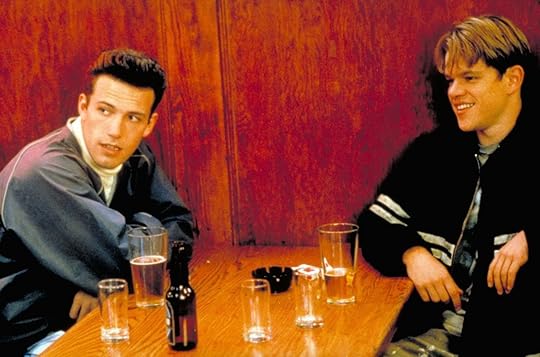
When a character in a movie grabs a drink, the real-world filming location is often a set. Sometimes it’s an actual bar, however, and occasionally that bar is a place where you, too, can grab a drink.
Visiting movie locations can be exciting when it looks true to the movie, confusing when it doesn’t, and disappointing when it’s turned almost entirely into a tourist trap. The Cheers bar in Boston was once one of the most famous real-world bars from the screen, though it permanently closed in April 2020 due to economic hardship from the pandemic. Others have managed to survive, however.
These are the famous bars you can drink at that have made it into the movies.
1. New York Bar in Tokyo from Lost In Translation
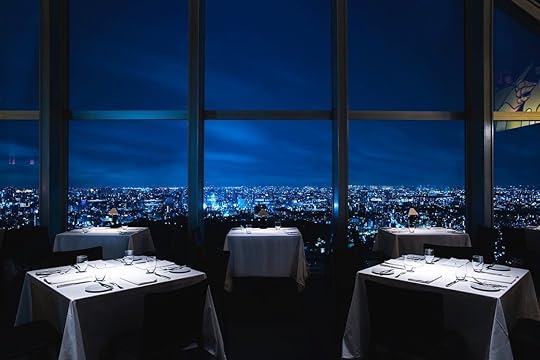
Photo: Park Hyatt Tokyo – パーク ハイアット 東京/Facebook
The New York Bar is at the top of the Park Hyatt hotel on the 52nd floor, with floor-to-ceiling views that look out over Tokyo and, if the weather is clear, straight to Mount Fuji. The bar is pure luxury — and fits perfectly in the world of Sofia Coppola’s 2003 movie Lost in Translation starring Bill Murray and Scarlett Johansson. Murray’s character, Bob Harris, is in Tokyo to shoot an advertisement for Suntory Whisky’s Hibiki 17 Year, and a fair amount of time is spent in the New York Bar. The connection between the bar and the movie is still alive all these years later.
There’s a cocktail called the L.I.T., which the Telegraph notes draws inspiration from the color of Johansson’s outfit in the beginning of the movie. There’s also plenty of Japanese whisky. Hibiki 17 was discontinued by the distillery, but the bar has the 21 and 30 year available by the glass. The bar describes itself as “more New York than New York” on its website, with weekly jazz and live entertainment. Just keep in mind you need the dining budget of a Hollywood star to enjoy the drinks menu.
Where: 3-7-1-2 Nishi-Shinjuku, Shinjuku-ku パーク ハイアット 東京 52階, Tokyo 163-1055, Japan
2. 7B Horseshoe Bar aka Vazacs in New York City from The Godfather: Part II
In 1935, a catering hall named Vazacs opened in Manhattan’s Alphabet City. According to the bar’s own history, it picked up the name “Horseshoe Bar” because of the horseshoe-shaped bar inside. The “7B” comes from the street corner where the bar is located. The building has seen a lot of changes over the years — including a mention in the novel The Golden Spur and a brief time when apartments took up the second floor — but its main claim to fame is its role in movies.
It’s here that the Rosato brothers attempt to kill Frank Pentangeli in 1974’s The Godfather Part II, and can be seen in the background later as a shootout takes place on the streets. It’s also in the 1986 movie Crocodile Dundee, where the titular character tries to pick up on, and then assaults, a trans woman and yells, “A guy dressed up like a sheila! Look at that!” It’s also the setting for a beer chugging bet between Ashton Kutcher and Rob Corddry in What Happens in Vegas. The TV shows Law and Order and Sex in the City have shot scenes here as well. For the full dive, check out a supercut of the bar’s many televised appearances before visiting for a drink.
Where: 108 Avenue B, New York, NY 10009
3. The Blind Donkey in Long Beach from La La Land

Photo: The Blind Donkey Long Beach/Facebook
Sebastian (played by Ryan Gosling) and Mia (played by Emma Stone) meet for a final time onscreen toward the end of La La Land at Sebastian’s swanky jazz club, Seb’s. It’s as classy in the movie as a jazz bar should be, complete with spot lighting and tightly packed tables. In real life, it’s the Long Beach, not Los Angeles, location of The Blind Donkey. The bar has long tables and arcade games rather than candlelit tables for two. The main attraction isn’t jazz, but is arguably The Blind Donkey’s long and inclusive spirits list with whiskeys from America, Ireland, Scotland, Japan, Taiwan, France, and Canada. It’s a much more lively looking place in real life than it is in the movie.
Where: 149 Linden Ave, Long Beach, CA 90802
4. L Street Tavern in Boston from Good Will Hunting
It would have been very easy for L Street Tavern to sell its soul to the many visiting fans of Good Will Hunting. It looks similar to the cheap pub it’s supposed to be in the movie when Will (played by Matt Damon) downed beers with his buddies, only the real Southie bar sells branded clothing and has a Good Will Hunting poster on the wall. Still, L Street Tavern has maintained its status as a local stop to watch sports and hold political events, according to The Infatuation.
Where: 658 E 8th St, Boston, MA 02127
5. Sky Bar in Bangkok from The Hangover II
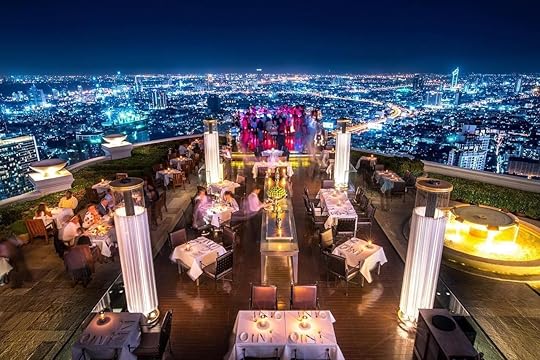
Photo: lebua Hotels and Resorts/Facebook
Even Ed Helms’ fake face tattoo couldn’t distract from the views when Bangkok’s Sky Bar made an appearance in The Hangover II. In the scene, the Hangover crew meet Kingsley (Paul Giamatti) to unsuccessfully negotiate the release of Teddy (Mason Lee). All while perched on one of the highest rooftop bars in the world — perfect for the part of the scene when a military helicopter rises to the bar’s level in the background.
Sky Bar embraces its role. It cheekily references the appearance on its website by referring to the fact that guests might recognize it from “a certain movie.” Sky Bar also has a drink called the Hangovertini, which sells for around $35 and is made with Chivas Regal 18 Year, vermouth, rosemary shrub, and maple syrup. But it’s somewhere you’d want to go even if you absolutely hated The Hangover II. It’s located 820 feet in the air, and, though pricey, offers unparalleled views of Bangkok.
Where: 1055 Si Lom, Silom, Bang Rak, Bangkok 10500, Thailand
6. The Prince in Los Angeles from Chinatown
The Prince has the red-lit feel of lounges and steakhouses from a different era. That’s part of the reason it’s had such a great run on the big screen. In Roman Polanski’s 1974 movie Chinatown, Jake Gittes (played by Jack Nicholson) and Evelyn Mulwray (Faye Dunaway) meet here. The horseshoe bar in the middle of the main room also makes a couple appearances in Mad Men, and it’s the bar of choice for the magicians in the comedy The Incredible Burt Wonderstone. Its plush red leather booths and quirky lighting make it a good setting for just about any throwback classy bar.
The real bar is in LA’s Koreatown. It was first dubbed The Windsor when it opened in the 1940s, according to Curbed. The space was decked out with small statues of the British soldiers of yore, stained glass, and oil paintings. When it was purchased by another owner in 1991, that all stayed the same while the name changed to The Prince and the menu switched to Korean food. The blending of old and new works, making it the perfect backdrop for so many movie and television sets.
Where: 3198 W 7th St, Los Angeles, CA 90005 
More like thisEntertainment13 famous restaurants from TV and film you can actually eat at
The post 6 bars from movies that you can actually drink at appeared first on Matador Network.

People named Orlando free flights

If you happen to be named after the home of Disney World, you’re eligible for a $250 voucher on Frontier Airlines. The catch is, you can only fly to — you guessed it — Orlando.
As part of a promotion with Visit Orlando, Frontier Airlines is offering anyone with the first or last name of Orlando a travel voucher for $250 to Orlando International Airport. Travel dates are valid between October 13 and October 20, and applicants must fill out an online form and claim the voucher by October 5.
The goal of the promotion isn’t just to encourage people named Orlando to visit their namesake city, but to boost tourism in this part of Florida. To incentivize the vast majority of non-Orlandos to visit, Frontier has also launched a sale on flights to the city with one-way fares as low as $39.
You might be tempted to lie your way to a free voucher, but unfortunately that won’t be possible. Once you complete the form, Frontier will be in touch with you to confirm your name, and if you lied, that’s going to be pretty embarrassing. After confirmation, you’ll be sent a voucher.
The promotion is similar to Frontier’s Green Week initiative last year, which was 
More like thisTheme ParksWhen the sun sets over Disney World, the real fun begins
The post appeared first on Matador Network.

Everything to know about bikepacking
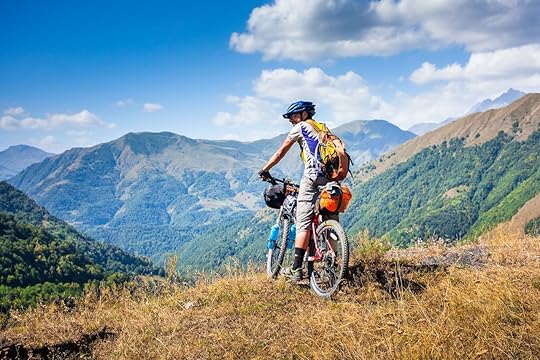
The term “bikepacking” is a play on “bicycle touring” and “backpacking.” It’s an improvement on both. The simple fact that you’re on a mountain bike frees you from the need to stay on asphalt and opens an entire world of possibilities that road cyclists can only stare at from a distance. And cycling is far more efficient than walking as a means of covering ground.
On the first weekend of autumn, I embarked on my first bikepacking trip. The route from my house in Palisade, CO, took me 43 miles across the mostly-paved Colorado River Trail along with stretches on gravel trail, singletrack, and road to Highline Lake State Park. I camped there. In the morning I rode the park’s singletrack trail system and backcountry roads before joining the Loma-Fruita Bikeway and eventually the Colorado River Trail back toward Palisade. Here’s what I learned from the experience, and here’s what you need to know to make your first bikepacking trip as smooth as possible.
Choosing a bike for bikepacking
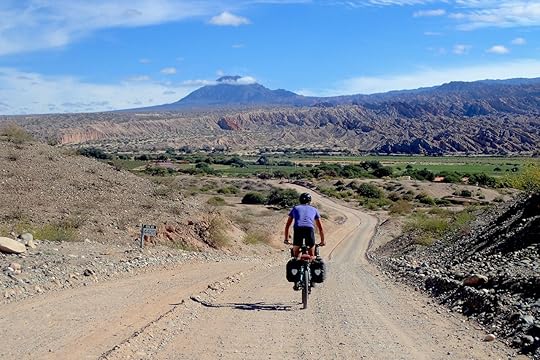
Photo: Sophie Castillo 1986/Shutterstock
A hardtail mountain bike — meaning it has suspension on the front but not the rear — is ideal for bikepacking trips traversing across mostly dirt roads, gravel, and non-technical singletrack. Hardtails don’t absorb bumps as well as full-suspension bikes. But they’re much more efficient for distance pedaling and are lighter in weight. If you plan to affix a rack or other semi-permanent add-ons to your bike, you may be forced to use a hardtail simply because many technical mountain bikes aren’t designed to hold such gear.
If your route spends ample time on technical singletrack, a full-suspension bike is worth the extra weight in exchange for saved energy and frustration. In this case, opt for the bikepacking-specific packs discussed below.
To reduce the chances of a popped tube, I kept my tire pressure around 30 PSI. The harder the tire, the less the ability to absorb awkward contact. I also took the bike in for a full tune before departing and had gear for light maintenance. As such, I wasn’t stressed every time I rode over a bump or rock.
Packing for a bikepacking trip: the overnight must-haves
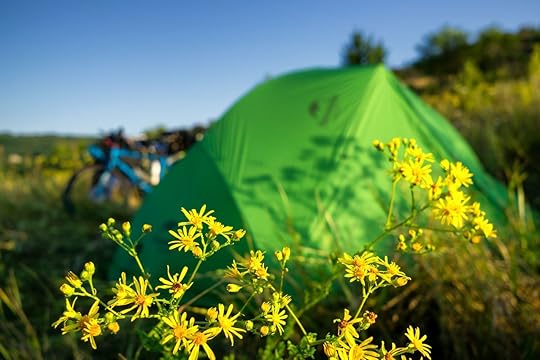
Photo: Maxim Burkovskiy/Shutterstock
Not to draw from a millennial cliche, but minimalism is essential on a bikepacking trip. Heavy or oversize camping gear will make riding trails more difficult and cause you more stress than the added comfort is worth.
Though any small and easily backpackable one-person tent will do, the biggest change I’ll make before my next bikepacking trip will be to obtain a lighter overnight setup. With a standard 1-2 person tent and a three-season sleeping bag strapped to a rack on the back of my bike, I carried more weight than I needed to.
When buying a tent specifically for bikepacking, opt for a one-person tarp-style tent such as the Fly Creek HV UL1 from Big Agnes or go all-in with the Tarptent Aeon Li. Some bikepackers choose to go with just a camp tarp or bivy bag when the weather looks clear. The closer you’re willing to get to nature, the reward is less gear to carry.
Compact sleeping bags such as the Trailbreak series from REI are ideal for packing in one of the pack setups listed below. A sleeping pad and down quilt can save space on even that, provided inclement weather is not in the forecast.
If you must have a full setup or if traveling with another person and sharing a larger setup, strap a tent and backpack(s) to a rack affixed to the back of your bicycle. Be sure to tighten the straps and test — the last thing you want is a bump in the trail sending your gear flying overboard. Though I didn’t have any issues, I’ll swap the pannier and rack for a handlebar bag next time for the sake of efficiency and comfort.
What else to bring on a bikepacking trip
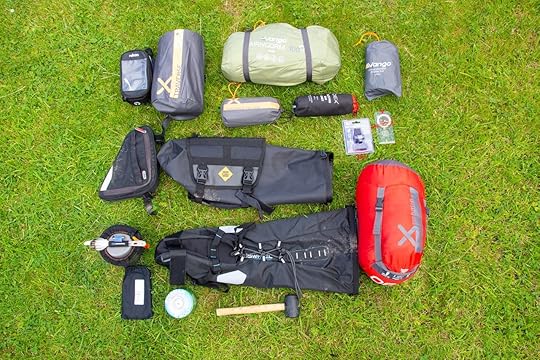
Photo: Juiced Up Media/Shutterstock
Backpacks are not ideal for bikepacking for a number of reasons. It’s tough to maneuver yourself, the pack straps can cause shoulder or back strain, and you have to stop to access the contents, among other things. The most important piece of bikepacking-specific gear you need is a frame bag. This triangular-shaped pack affixes within the bike frame itself, adding no external mass to you or your ride. Store items you’ll need on the fly like water or snacks, though the pack should also fit a bike lock, bivvy bag, and other small-to-medium-sized items.
For additional storage, opt for a front frame handlebar bag. Easy access bags such as this one from Ortlieb run about $160, though stripped-down duffel versions like this one from Birzman cut that cost in half and double as a dry bag, helpful in cases of rain or stream crossings.
You can get by with a traditional pannier attached to a rack above the rear tire as I did, but a handlebar bag is better for balance on uneven terrain. On a trip longer than two days, you may wish to add an additional pack such as this seat pack from REI, which attaches to the bottom of your seat in lieu of a rack. This is great for storing overnight gear.
Bike and safety gear
What happens if you pop a tube? Being prepared with proper maintenance and routing tools is an essential part to a successful bikepacking trip. The bike gear to have on you:
Spare tubes, portable pump, tire levers, a patch kit and plugs, and a bike multi-tool
Extra chain links and lube
Jerry-rigging stuff like straps and duct tape
Basic first-aid supplies, including gauze, bandages, tape, and ibuprofen
Phone charging bank and chords, sunscreen, and toiletries
Water
For most, four liters of water per person, per day, is a good starting point. If the trail spends much of the day in open heat, you may want up to six liters. A Camelbak or other water bladder plus a water filter that allows you to filtrate water on the go are necessities for any bikepacking trip.
Store your bladder in the bike frame bag for easy access on the go. Anytime you pass a visitors’ center, convenience store, or somewhere else with potable water, fill up the bladder. You’ll thank yourself later.
Food
Because you’re on a bike, the key to an optimized meal setup is portability. Anything that takes excessive preparation or storage won’t cut it. Lightweight, pre-packaged backpacking meals like Patagonia Provisions make perfect dinner meals that are quick and can be cooked over a portable butane stove or alcohol stove, both of which fit into the frame or handlebar bag. Brave makes nutrition-enhanced, on-the-go oatmeal breakfasts ideal for a quick and healthy morning meal. I particularly enjoyed the Peanut Butter Banana flavor on this trip. Quick snacks like Clif Bars and fruit are mandatory for rapid-fire calories.
I brought just enough food and water — two backpacking meals and some high-calorie snacks — and I had a filter and routed myself to a place where I knew there’d be water.
Planning your bikepacking route
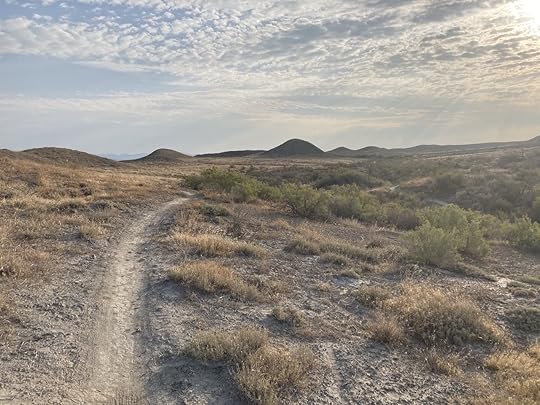
Photo: Tim Wenger
Now it’s time for the fun part: figuring out where you’re going to pedal to, and what you’ll see along the way. Bikepacking is unique from most other outdoor adventures because you don’t necessarily have to end up where you started. Long-distance trails such as the 142-mile Kokopelli Trail, which traverses desert and mountains between Fruita, CO, and Moab, Utah, are popular because they offer a challenging route that actually takes you somewhere. By stationing or arranging a shuttle vehicle or public transit at your finish point, there’s no need to go both ways — unless you want to.
For your first bikepacking trip, pick a terrain and route that you are at least partially familiar with and will be comfortable riding. Use Bikepacking Roots to identify and plan your route. Then, use a bike-centric GPS app on your mobile device such as GaiaGPS or Strava to input starting and ending points, overnight stops, water refill points, and additional waypoints. Bikepacking covers popular routes and gear and offers advice from pioneers of the activity. Rotatable smartphone mounts to monitor the app, such as this one from Nite Ize, start around $20.
If you’re nervous about biking a long distance with all of this gear, as I was, plan a test route from a nearby trailhead to a campground or state park. Ride there, set up camp and spend the night, and then ride back to the trailhead. Take notes of what you did right and anything you’d change to your setup, planning, or execution, and then implement those changes before taking a longer trip. And if you are going by yourself, always tell someone where you are headed. 
More like thisSustainabilityTake a car-free Colorado road trip with a bike, bus, and zero added emissions
The post Bikepacking is the coolest new way to get outdoors appeared first on Matador Network.

September 30, 2020
Latina travel influencers

The Hispanic and Latinx population makes up the largest minority group in the US. With a reported spending of $56 billion per year on leisure travel by the demographic worldwide, you would not be wrong to question why there is not a larger representation of Latinx travelers in the industry and travel narrative at large. The lack of relatable marketing is striking — but in the social realm, Latinx travel bloggers and influencers are crushing it. From money-saving ideas to tips on solo female travel, these Latina travel influencers showcase inspire us all not only to up our social media game but also travel bravely and be ourselves.
1. Luz Carreiro, @bee.traveler
View this post on Instagram
'A Life On Our Planet' interview
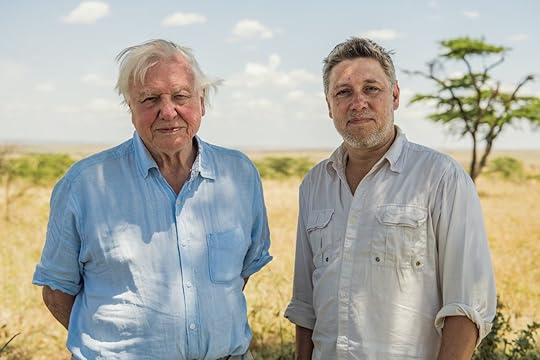
“I do hope that people will leave hopeful,” says Jonnie Hughes, director of David Attenborough’s new film A Life On Our Planet, which premieres on Sunday, October 4, on Netflix. “I would like them to feel energized to make changes but also demand changes as well.”
Leaving the viewer hopeful seems a tall order, given the film chronicles the rapid devastation of our planet’s wildlife in just one lifetime — albeit a long one. Attenborough is 94 years old, and he’s been making nature films since the 1950s. The narrator behind such celebrated series as Our Planet and Blue Planet is widely seen as one of the world’s top authorities on wildlife. In fact, when he opened an Instagram account this week, he hit a million followers faster than anyone else has.
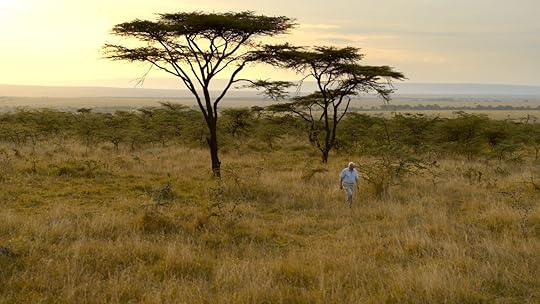
Photo: Keith Scholey/Silverback Films
“There are very few places he hasn’t been. And so you have this kind of unique perspective on the world over a unique period of time,” says Hughes, who together with other members of Silverback Films has worked with Attenborough on films related to the Our Planet series.
“In many ways, the film is his witness statement,” says Hughes. “He’s laying out his understanding of what’s happened to the planet during his lifetime, and it’s a sorry tale.”
As Hughes points out, in the past 50 years, wildlife populations have halved or more than halved. The World Wildlife Fund says human activities have set wildlife in a “freefall.” Hughes notes that all the wild mammals that Attenborough shows in his films are a mere fraction of the mammals living on Earth.
“So all those zebras and whales and bats and kangaroos, that’s only four percent,” of the mammal biomass on Earth. The rest are us and the mammals that we eat or keep as pets, says Hughes. “That’s the imbalance that we’ve got to.”
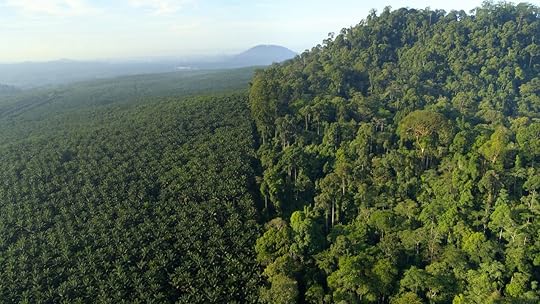
Photo: David Attenborough: A Life On Our Planet/Netflix
This matters, says the filmmaker, not because wildlife is “nice to have.” Rather, it’s because science has shown that “if we don’t have a biodiverse planet, it doesn’t function well. It stutters, it goes wrong, it breaks,” says Hughes. “And we are the most demanding species on the planet, so it’s going to affect us more than anything.”
How then is there reason for hope? After all, says Hughes, “The status of the planet at the moment is disastrous.” Indeed, the middle portion of A Life On Our Planet, which catalogs the havoc humans have let loose on the planet, is “pretty hard hitting.” Hughes says that over the two weeks editing the bleakest scenes, it was hard to sleep well at night.
Yet Hughes’ cause for hope — to which the film dedicates in its final thirty minutes — lies in the same source of the destruction: us.
In this way, the film departs from other nature documentaries that Hughes and his team have worked on, because its subject is not just wildlife, but human beings. The film seeks to capture humans as a whole — rather than on the individual level — since it’s at that level that we are impacting that planet…and can hopefully also save it.
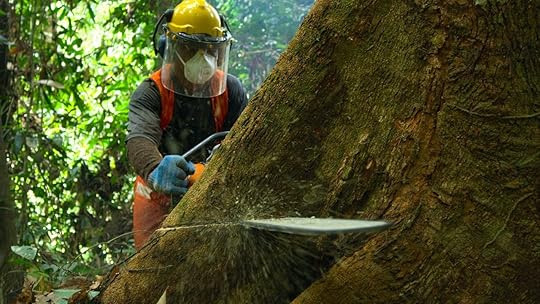
Photo: David Attenborough: A Life On Our Planet/Netflix
“Normally I’m filming polar bears and tigers. I really enjoyed that I could, with the same kind of production values, approach filming human beings, and show them off not only for their worst, but for their best qualities as well,” says Hughes.
“This is more about us as a species. So let’s pull back a little bit and watch what happens and let them be themselves because that’s the fascinating bit about what you’re filming,” says Hughes. In the same way that in filming wildlife, you don’t want your presence to alter the animals’ behavior, the approach with people was the same. “We did stand back. We did have our long 50 to 1000 mm lens,” he says.
The goal was to capture the full scope of who humans are, says Hughes. “We wanted to show that balance. We wanted to show how amazing we are, really. That we’re so impactful and yet have such potential.”
From a stadium full of cheering fans to a human tower made in Catalonia, Hughes says the film contains imagery that ponders, “‘Aren’t we amazing, aren’t we weird, aren’t we devastating, aren’t we creative?’ It’s all the things, we are this compound of conflating qualities that not only got us into this mess. It’s also going to get us out of this mess.”
The road out of this mess is clear, says Hughes. He cites Attenborough’s straightforward prescription in the film: “‘We’ve got to rewild the world.’”
As Hughes notes, most of the world has come to understand the existential threat posed by climate change. What is less often mentioned is biodiversity loss. And yet he says this equally important issue is “very much related” to climate change.
“There’s another equal and opposite term [to climate change], and that’s biodiversity loss,” says Hughes. “That’s the other flashing red light on the dashboard at the moment. And not enough people are talking about it.”

Photo: David Attenborough: A Life On Our Planet/Netflix
That climate change negatively affects biodiversity is well documented. We know that our climate is changing at a speed that makes it hard for wildlife to adapt, and that biodiversity is under serious threat. But what Hughes says the film aims to show us is that improving biodiversity can actually help mitigate climate change.
“They’re twin problems and they’re twin solutions,” says Hughes. He says studies suggest that if farmers would simply allow a few trees to regrow near a field, the collective impact of those trees in absorbing carbon would be tremendous. Indeed, if the pandemic has shown us the threat posed by biodiversity loss, in terms of creating conditions for wildlife-borne diseases, it has also shown us how readily nature bounces back when left undisturbed.
The film trains the camera on human initiatives around the world that are proving exactly that. For example, as oceans are so critical to the health of the planet, we need to leave a third of coastal and deep-sea waters undisturbed.
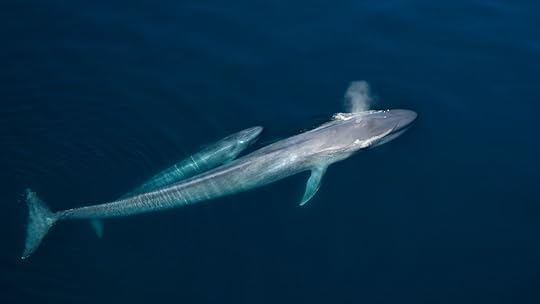
Photo: David Attenborough: A Life On Our Planet/Netflix
“Fish populations will do so well in those protected areas that they’ll spill out into the neighboring areas and actually all the local fishing communities will catch more fish, and that’s not fantasy,” says Hughes. We see real-life examples of that in Mexico and Alaska, he says, which affirm that rewilding the world is a benefit for everyone.
In fact, protecting a section of our oceans so fish species can recover is one of the film’s five prescriptions. A second one is drastically reducing our consumption of meat. That will allow our land to reforest, a third needed action.
The fourth step is reaching a plateau in our population as soon as possible, something that will be achieved with education of girls and increased living standards — yet another win-win scenario; or, as Hughes says, “the sort of thing we’d want to do anyway.”

Photo: David Attenborough: A Life On Our Planet/Netflix
Lastly, we need to get off fossil fuels. Hughes points out that, beyond a few creatures living by hot vents in the deep sea, “99.9 percent of the living things on Earth are directly solar powered, or eat things that are solar powered.” The film shows examples of humans harnessing that power, as well as other forms of renewable energy, such as wind or water.
We have the capacity to make changes in our life — like going vegetarian, as Hughes himself did during the making of A Life On Our Planet — but also of demanding larger scale transformation. We can ask pension funds to divest of fossil fuels, for example.
Hughes paraphrases Attenborough’s observation in the film, “It’s crazy that we’re using our pensions, and our savings are investing in fossil fuels, when those are the things that are ruining the future we’re saving for.”
“We’re all voters and consumers,” says Hughes, and he wants us to take the message of the film and get out there and work for change. “This is a period of time in which we are destabilizing and ruining the planet. But there’s an equal and opposite reaction that we are so powerful that we are able to influence the planet.”
These things aren’t difficult, says Hughes, but they “need to be done on an international scale.” A good start is educating people about the state of things and motivating them to both act and to demand action. “From my point of view, I want as many people to see it as possible.”
So watch A Life On Our Planet this Sunday and tell your friends to watch it. And then eat less meat, make your next car an electric one, vote, and demand change. And above all, don’t lose hope. 
More like thisNewsSir David Attenborough is teaching geography to kids during lockdown
The post The director of David Attenborough’s new film wants you to have hope appeared first on Matador Network.

Matador Network's Blog
- Matador Network's profile
- 6 followers



